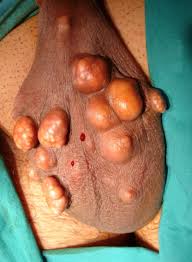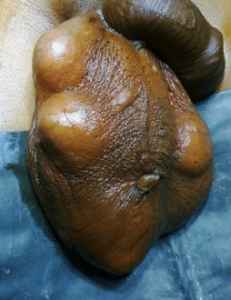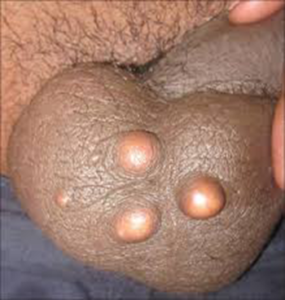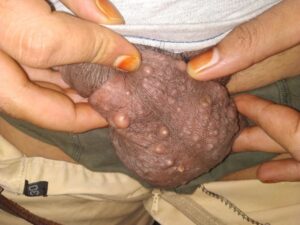Scrotal nodularity is not common. It is present in the age group from 20 to 40 years male. In medical terms, we call it scrotal calcinosis. But when it appears it looks very ugly and shameful.
Any pathology to the scrotum testis or penis is mental stress for men. Scrotal calcinosis is one of them
It looks so disturbing to men that they develop mental stress. But due to shame, they could not consult in the early stage. Another reason could be the painless nature of such a lesion. Hence let’s see what are these lesions.
What are these lesions?

There are two possibilities 1) scrotal calcinosis 2) multiple sebaceous cysts.
externally these pathologies look very similar but these two are different and not possible sometimes to differentiate only on clinical examination. Its nature is only revealed in histopathology.

What is scrotal calcinosis
Calcinosis means the deposition of calcium. Calcium deposition is not uncommon for the human body. With such calcium renal calculus develops. Similar deposition occurs in the scrotal skin also. Scientists could not find the reason behind these calcium depositions. Hence it is called idiopathic calcium deposition. Idiopathic means the pathology of which could not be found out or explained. means it develops spontaneously on its own.

What happened in scrotal calcinosis.
Scrotal calcinosis at the early stage shows very small nodules over scrotum skin. It is not painful and never develops itching too. As it is painless, a patient used to ignore it always. And never consult any doctor for this pathology. Over around 5 to 10 years, it may grow in size gradually and attend a size of about 2 to 10 mm.
At this stage, the patient feels very shameful in front of his partner or friend. For this cosmetic reason, he consults a doctor now. Scrotal calcinosis used to occur in males of dark colour. Again the reason behind this is unclear. The commonest age group is 20 to 40 years. We can see this condition in females also. They have vulval calcinosis but it is a very rare condition than Men.
scrotal calcinosis.
In this condition, multiple small to large of varying sizes nodules develop over scrotal skin. It looks yellow in colour and looks ugly. These are irregular in shape. Although it is a benign condition, it looks sometimes like cancer means a malignant condition. It never produces pain but with increasing size, some itching may develop. Sometimes they make it ruptured to ooze inspissated yellow calcific material.
What is a scrotal sebaceous cyst?

Although both pathologies seem similar on external inspection, there are some minute differences. The colour of the nodule of scrotal calcinosis is dark yellow to red whereas the colour of the sebaceous cyst is reddish to black. The shape of a sebaceous cyst is many times rounded whereas calcinosis is an irregular shape. Because sebaceous cysts have a cyst wall over them that lacks scrotal calcinosis. Sebaceous cyst May be painful if it gets inflamed. The redness would be there due to infection.
Itching is very common in sebaceous cysts.
The main difference in calcinosis is that the calcium deposit occurs without cyst formation. But sebaceous cyst is a cyst formation under the scrotal skin.
Who is the consultant for treatment
You may be confused as to whom you need to consult. Whether a skin specialist or General Surgeon. The answer is both are good to correctly diagnose this condition. But skin specialists could not correct it with medicine. In fact, there is no medicine for the treatment of scrotal calcinosis or scrotum sebaceous cyst. Ultimately skin specialist will refer you to a surgeon for surgery. Hence you can directly consult to General Surgeon for this type of scrotal lesion.

What is the treatment?
As stated earlier, surgery is the only treatment that is the gold standard for this pathology. If the lump is single or double, the surgeon will decide whether to excise them with or without surrounding skin. But if lesions are multiple all scrotal skin, then the surgeon will decide whether excise scrotal skin or not. With excision of the scrotal skin, he can close the scrotum but sometimes if the involvement of skin is large, the scrotum cannot be closed. In such a condition, he may decide to put a skin graft over the scrotum for better healing.
Chances of recurrence
Chances of recurrence are very few but could happen in both cases. This is due to leaving of micro calcium deposition in scrotal skin or leaving micro sebaceous cyst within the skin. If recurrence occurs, we can manage it efficiently within a time. There is no fear of the development of cancer.
Complications
These lesions will not transform into cancer anytime, although it has a recurrence rate. Recurrence is also very few in percentage i.e 1 to 5 per cent only. These lesions will not cause any metabolic changes to our body and will not develop any sterility in males. Although there are chances of mental stress which could be lead to loss of libido. This will not cause any malformation to sperm Genesis or difficulty in the micturition process.
Conclusion
Whenever you note such lesions, you must consult your General Surgeon without hesitation. Keep in mind that only Surgical Management is there for such lesions. Hence prepare your mind for surgery. Most of the time, this surgery is done under local anaesthesia which does not require any type of hospitalization. Hence come forward for a timely checkup and go for the treatment.
Thank you.
If you have still any questions regarding this pathology in your mind, don’t hesitate to mail me. Please mail me at masram2017@gmail.com.
If you have another problem other than this and want a second opinion, you can send your scan documents to my email with a short description of your suffering. I will try to solve your problem asap.
